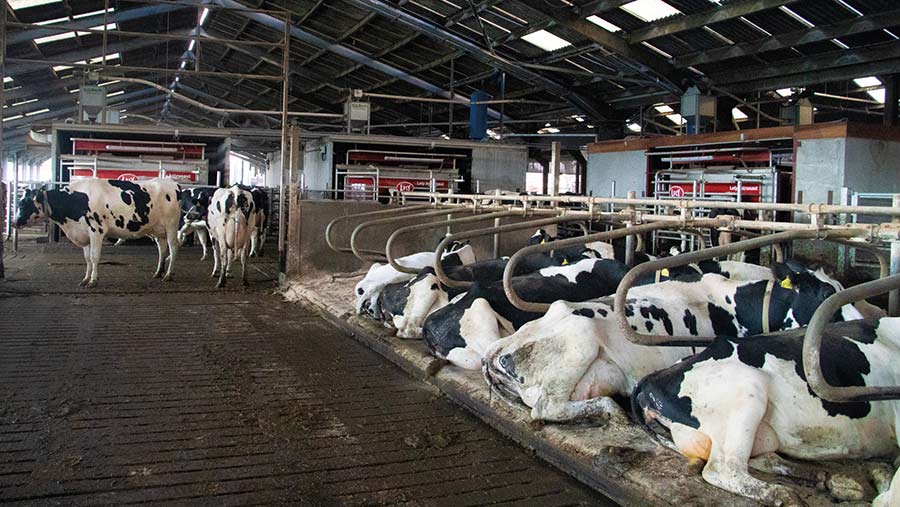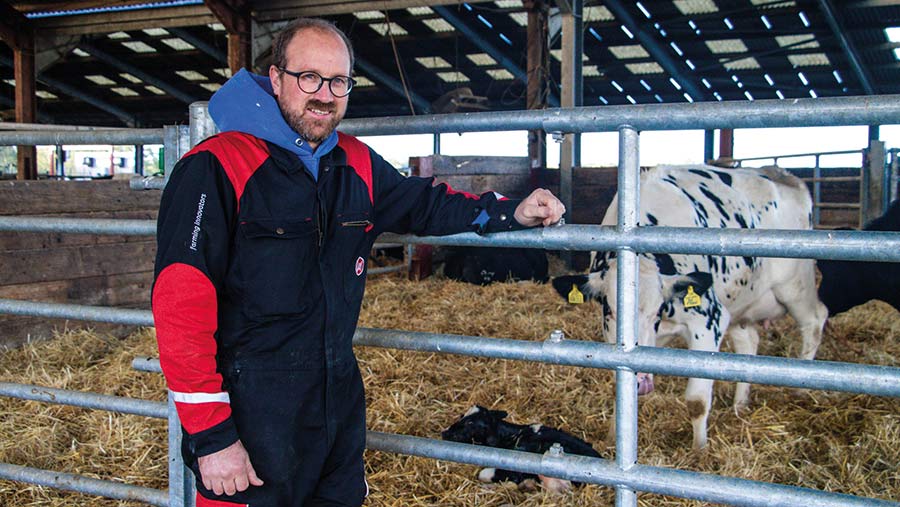Advice on observing housed cows to improve dairy sheds
 © MAG/Rhian Price
© MAG/Rhian Price Taking the time to watch your cows can help pinpoint where improvements need to be made inside sheds.
Cow behaviour can tell you a lot about how good your management is and tuning into that behaviour can help improve the health, welfare and productivity of your herd.
CowSignals is a training programme that teaches farmers how to observe cow behaviour and works alongside the AHDB to run workshops on the fundamentals.
See also: 6 fresh cow checks to prevent problems after calving
What is CowSignals?
Cow Signals is a training programme to educate farm staff and technicians into a holistic approach to cow management, focused on prevention rather than treatment.
By applying science and research, the CowSignals system uses checklists and targets to make stockmanship more objective by quantifying herd comfort and cow contentment.
It is taught by over 400 trainers working in 50 countries.
Find out more about CowSignals
Independent vet and CowSignals trainer Owen Atkinson explains some crucial aspects of housing to get right to ensure cows have an environment that meets their needs and promotes health.
A checklist is a good starting point when observing cows, so things do not get overlooked, he advises.
Water
Cows require about 4.5 litres of water/kg of milk produced – for a high-yielding Holstein producing 40kg daily, that equates to 180 litres of water/day.
Water must be clean and palatable.
Targets:
- 10cm a cow of space at the water trough
- Ensure troughs are cleaned regularly.
Feed
Feed must be easy to access and palatable to encourage good intakes.
“Farmers will often say it doesn’t matter if [cows] don’t have one feed space each because they don’t all eat at once.
“But cows are herd animals; eating is a learned thing and if you don’t have one feed space [for each] cow, less dominant cows get the worse stuff and it also interferes with their feeding pattern,” says Mr Atkinson.
Cows with limited access will also eat less frequently and will eat bigger meals, which upsets rumen stability.
The target for rumen pH is 5.5-6.5; if the rumen dips below 5.5, the cow suffers from acidosis and feed efficiency drops off a cliff, he explains.
Housed cows eat less frequently than grazed cows because the diet is drier, although this is weather dependent.
Cows will graze less in sub-optimal weather conditions, and therefore rumen pH can be more inconsistent in housed herds.
Targets:
- 65cm a cow at the feed fence
- Cudding: eight hours a cow a day
- Housed cows should spend four to five hours eating (spread over at least six bouts)
- Grazed cows would typically spend eight to nine hours eating and will eat more frequently (about 12 times a day)
- Push feed up at least four times daily.
Fresh air
Milking cows have a high metabolic rate and can find it difficult to stay cool. A high-yielding Holstein works at four times maintenance when she is milking – harder than Usain Bolt during a sprint.
Unlike humans, cows do not sweat a great deal. They lose heat by breathing faster. But if there is no fresh air, they cannot do this as effectively.
Targets:
- Normal breath rate of a cow is 20 breaths/minute
- A rate above 30 breaths/minute indicates the cow is heat-stressed
- Optimum temperature is 5-10C
- Use fans to cool cows.
Light
Good levels of light are important for feed intake and fertility. The latter is often overlooked, but optimum light and dark periods affect the production of the fertility hormones regulating oestrus.
Cows have very different eyesight to humans and have almost 360deg panoramic vision.
They can see much better in the dark than humans because they have a light-reflecting surface called tapetum lucidum located at the back of the eyeball. This reflects light within the eye, amplifying low levels of light.
Sheds should be constructed to make the best use of daylight to achieve at least 200 lux.
Lighting can be measured inside sheds using a light ambient meter.
Targets
- Provide 16 hours of light at >200 lux
- Eight hours of darkness at <50 lux
Space and rest
Observing “waiting” cows – the ones not eating or lying down in cubicles – can tell you if the shed is offering adequate cow space and comfort.
A lot of these “waiting” cows will show an intention of movement, such as placing one foot forward and then drawing it back again. The target is to have fewer than 15% of these animals in your herd at any one time.
To prevent waiting cows, good cow flow and adequate space are essential.
If accommodation does not have ample space, consider whether outdoor loafing areas could be provided.
For Holsteins, cubicles should be a minimum of 1.8m in lying length with an additional 75cm of free space in front of the brisket locator for their head, and an additional 75cm for lunging when they get up.
If cows are lying diagonally in cubicles, it is a sign that the space in front of the brisket locator may not be long enough, or that there is interference in front, such as metal bars.
Short cubicles decrease lying times and will make beds dirtier. If cows have lesions, this can indicate that they are not lying straight, and this is usually due to not enough free space in front, or that the cubicles are too narrow.
Targets
- Ensure passageways are 4m
- Fewer than 15% of “waiting” cows
- One cubicle for each cow to encourage good lying times
- Total space of at least 10sq m a cow
- Cows should be lying down for 12 hours/day
- Use brisket boards to help position cows in cubicles, no more than 10cm off the ground
- Cubicle dimensions: 1.8m long beds by 1.2m wide. Single cubicles should have 1.5m in front of the brisket board. Head-to-head should measure 5.1-5.5m kerb to kerb
- Cubicle comfort index: divide the number of cows lying by those that are in contact with a cubicle. Target should be at least 85%
Owen Atkinson was talking at an AHDB CowSignals event at Huddlestone Holsteins, Steyning, Sussex.
Case study: Huddlestone Holsteins, Steyning, West Sussex

Liam Tierney © MAG/Rhian Price
Farm facts
- Milking 420 cows, averaging 12,100 litres/year at 4.3% fat and 3.5% protein (940kg milk solids a cow)
- 28% pregnancy rate
- Averaging 3.1 visits a cow through robots
- Farming 809ha (2,000 acres) across two farms
- Milk sold to Arla.
The Gue family have just installed their seventh Lely robot and switched off their rotary parlour.
The decision to automate milking was taken to improve work-life balance at the 420-cow dairy.
Before switching to robots, cows were milked three times daily and lights never went off for long periods of time.
Now, lights go out for at least four hours, from 1.30am until 4.30am after final checks, and a sensor is used in the day to calibrate daylight, with lights automatically switched on when daylight doesn’t meet 200 lux for 16 hours.
This has helped contribute to a 2-litre lift in yields, says senior herdsman Liam Tierney.
Siting the robots in an existing shed has been more challenging than erecting a purpose-built unit, but they have taken the opportunity to make improvements to the existing setup.
Good overall space of 12sq m a cow is provided using an outdoor loafing area, and the shed is light and airy with no dead ends. Fans ensure good airflow on days with little wind.
Mr Tierney now wants to focus his attention on the low-yielding group where cubicle accommodation is not as spacious.
This results in some diagonal lying. To rectify this, the team plans to change the brisket boards.
The numbers
- 67cm Feed space a cow for dairy cows
- 12cm Water space a cow in high-yielding group
- 16 Hours of >200 lux light should be provided a day
